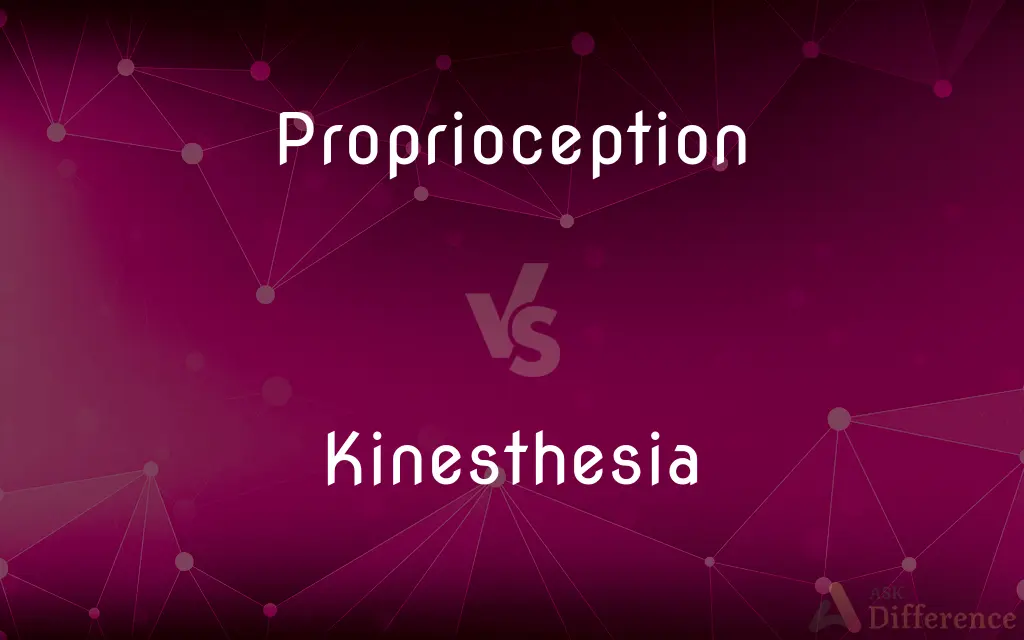Proprioception vs. Kinesthesia — What's the Difference?
By Fiza Rafique & Maham Liaqat — Updated on March 29, 2024
Proprioception is the sense of body position, while kinesthesia is the sense of body movement.

Difference Between Proprioception and Kinesthesia
Table of Contents
ADVERTISEMENT
Key Differences
Proprioception refers to the body's ability to perceive its position in space, enabling individuals to know where their limbs are without having to look. This sense is crucial for balance and coordinated movement, as it involves understanding the orientation of different body parts relative to each other and the environment. Kinesthesia, on the other hand, focuses specifically on the sensation of movement, including the speed and direction of body parts. It's essential for smooth and accurate movements, allowing people to adjust their force and timing as needed.
While proprioception provides the sensory feedback necessary for maintaining posture and stability, kinesthesia allows for the adjustment of movements in response to changes in the environment or task demands. Proprioception can be thought of as the static aspect of the body's sense, whereas kinesthesia represents the dynamic aspect, involving motion and change.
The sensory information for proprioception primarily comes from receptors in the joints, muscles, and tendons that signal information about body position and limb orientation. Kinesthesia, however, relies more heavily on the rate of change signals from these same receptors to inform the brain about the type and speed of movements being performed.
Proprioception is often tested by asking individuals to close their eyes and touch their nose with their fingertip, assessing their awareness of limb position without visual cues. Kinesthesia might be evaluated through exercises that require participants to replicate or adjust the speed of movements, emphasizing the perception of movement rather than position.
Both proprioception and kinesthesia are critical for performing daily activities and complex physical tasks, such as playing sports or playing a musical instrument. They work together to provide a comprehensive sense of the body in motion, contributing to our ability to move through the world with precision and grace.
ADVERTISEMENT
Comparison Chart
Definition
Sense of body position in space.
Sense of body movement, including direction and speed.
Focus
Position and orientation of limbs and body parts.
Movement dynamics of limbs and body parts.
Sensory Sources
Receptors in joints, muscles, and tendons.
Rate of change signals from receptors in joints, muscles, and tendons.
Importance
Essential for balance, stability, and coordinated movements.
Crucial for the smooth execution and adjustment of movements.
Evaluation
Assessed through position-awareness tasks, like touching the nose with eyes closed.
Assessed through movement replication or adjustment tasks.
Compare with Definitions
Proprioception
The body's sense of its own position in space.
Thanks to proprioception, she could walk in the dark without stumbling.
Kinesthesia
The sense of body movement, encompassing direction, speed, and force.
Kinesthesia allows a dancer to control the speed and fluidity of their movements.
Proprioception
Involves the perception of joint and body part positioning.
Proprioception allows a person to touch their finger to their nose with their eyes closed.
Kinesthesia
Essential for the accurate execution of dynamic activities.
Kinesthesia is crucial for athletes who need to adjust their movements in real-time.
Proprioception
Can be impaired by injury, leading to challenges in movement and coordination.
After the injury, his proprioception was compromised, affecting his balance.
Kinesthesia
Helps in learning new movements and correcting existing ones.
Kinesthesia plays a role in how quickly a child learns to ride a bike.
Proprioception
Critical for maintaining posture and balance.
Proprioception helps in standing on one foot without needing visual cues.
Kinesthesia
Involves the ability to sense muscle stretching and contraction.
Through kinesthesia, she could feel the extent of her arm's reach without looking.
Proprioception
A key component in the execution of coordinated movements.
Gymnasts rely heavily on proprioception to perform complex routines.
Kinesthesia
May be enhanced through practice and training.
Regular training can improve an athlete's kinesthetic awareness, leading to better performance.
Proprioception
Proprioception ( PROH-pree-o-SEP-shən), also referred to as kinaesthesia (or kinesthesia), is the sense of self-movement and body position. It is sometimes described as the "sixth sense".Proprioception is mediated by proprioceptors, mechanosensory neurons located within muscles, tendons, and joints.
Kinesthesia
The sense that detects bodily position, weight, or movement of the muscles, tendons, and joints.
Proprioception
Perception or awareness of the position and movement of the body
Exercises to improve balance and proprioception
Kinesthesia
Sensation or perception of motion.
Proprioception
The unconscious perception of movement and spatial orientation arising from stimuli within the body itself.
Kinesthesia
(physiology) The perception of the movement of one's own body, its limbs and muscles etc.
Proprioception
The sense of the position of parts of the body, relative to other neighbouring parts of the body.
Kinesthesia
(performing arts) A spectator's perception of the motion of a performer, or, the effect of the motion of a scene on the spectator.
Proprioception
The ability to sense the position and location and orientation and movement of the body and its parts
Kinesthesia
Proprioception or static position sense; the perception of the position and posture of the body; also, more broadly, including the motion of the body as well. See usage notes below.
Kinesthesia
See kinaesthesia, kinaesthesis, and kinaesthetic.
Kinesthesia
The perception of body position and movement and muscular tensions etc
Kinesthesia
The ability to feel movements of the limbs and body
Common Curiosities
Why are proprioception and kinesthesia important?
They are crucial for everyday activities, physical tasks, and sports, enabling smooth coordination, balance, and the execution of movements.
How does kinesthesia differ from proprioception?
Kinesthesia refers to the sense of body movement, including the speed, direction, and force, whereas proprioception is about body position and orientation.
Can you have one without the other?
While closely related, it's possible for someone to have impaired proprioception while retaining some kinesthetic abilities, especially in cases of neurological damage.
How can proprioception and kinesthesia be improved?
Both can be enhanced through exercises and activities that challenge balance, coordination, and movement control, such as yoga, dancing, or sports training.
Do proprioception and kinesthesia decline with age?
Yes, like many sensory and motor functions, they can decline with age, but regular physical activity can mitigate some of these effects.
Are proprioception and kinesthesia only important for athletes?
While particularly important for athletes, they are essential for everyone, aiding in daily activities like walking, writing, and other routine tasks.
What role do proprioception and kinesthesia play in rehabilitation?
They are key focuses in rehabilitation, especially after injuries or surgeries affecting movement, to restore functionality and coordination.
What is proprioception?
Proprioception is the body's ability to sense its position in space, helping to maintain balance and posture without visual cues.
How are proprioception and kinesthesia tested?
Proprioception is often tested through tasks requiring awareness of limb position without visual input, while kinesthesia tests focus on movement replication or adjustment.
Can injuries affect proprioception and kinesthesia?
Yes, injuries, especially those involving the nervous system or affecting joints, can impair proprioception and kinesthesia, affecting movement and coordination.
Share Your Discovery

Previous Comparison
Review vs. Reinforce
Next Comparison
Ketohexose vs. HexoseAuthor Spotlight
Written by
Fiza RafiqueFiza Rafique is a skilled content writer at AskDifference.com, where she meticulously refines and enhances written pieces. Drawing from her vast editorial expertise, Fiza ensures clarity, accuracy, and precision in every article. Passionate about language, she continually seeks to elevate the quality of content for readers worldwide.
Co-written by
Maham Liaqat













































